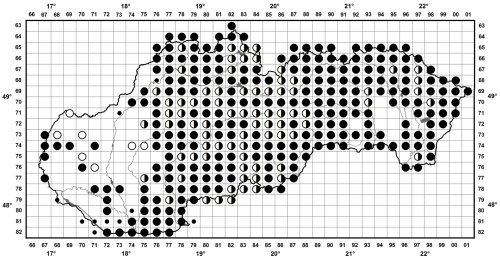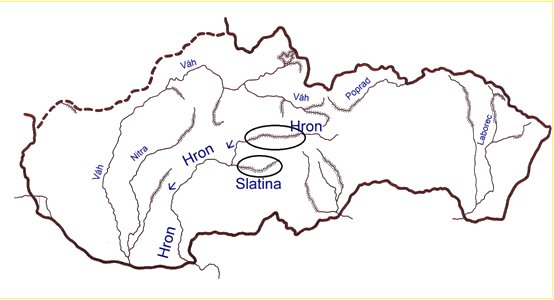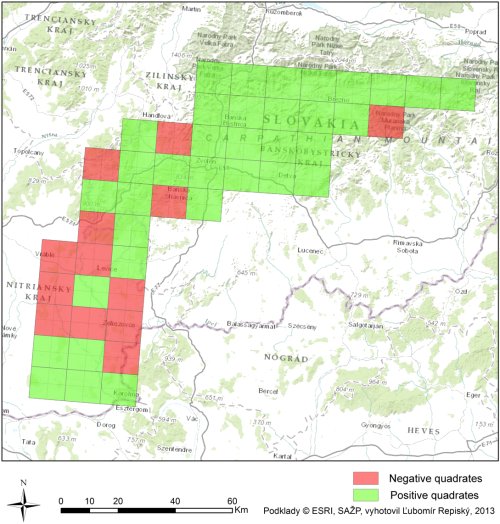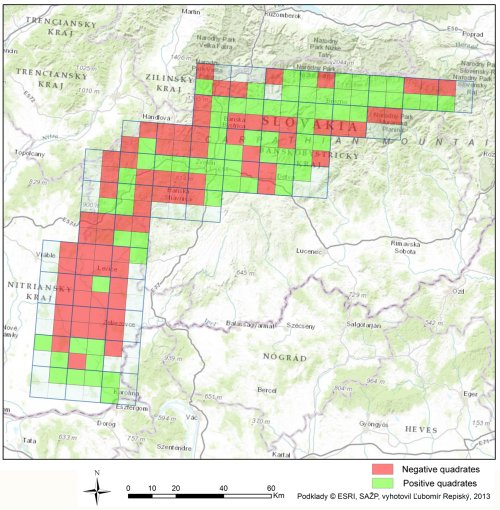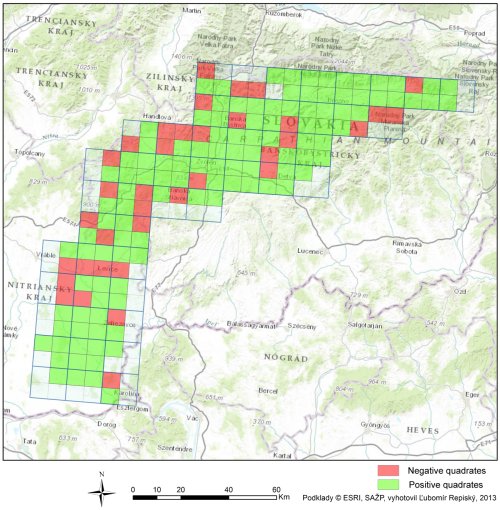IUCN/SSC Otter Specialist Group Bulletin

|
©IUCN/SCC Otter Specialist Group Volume 30 Issue 2 (October 2013) Citation: Urban, P. (2013). Re-Colonisation of the Eurasian Otter (Lutra lutra) in the Hron River Catchment (Slovakia) – a Preliminary Report from a Survey, or Who Reintroduced the Otter in the Hron River and Why? . IUCN Otter Spec. Group Bull. 30 (2): 78 - 102 Re-Colonisation of the Eurasian Otter (Lutra lutra) in the Hron River Catchment (Slovakia) – a Preliminary Report from a Survey, or Who Reintroduced the Otter in the Hron River and Why? Pter Urban1
1Department of Biology and Ecology, Faculty of Natural Sciences, University of Matej Bel, Tajovského 40, SK-974 01 Banská Bystrica, Slovakia.
.
email:Peter.Urban@umb.sk or urbanlutra@gmail.com |

|
| Received 25th May 2013, accepted 31st July 2013 |
| Abstract: The Eurasian otter (Lutra lutra) is widely distributed in Slovakia. The population of this species markedly decreased during the 20th century. In the last two decades an increase and a colonizing tendency of the population species range have been registered. A similar trend took place in the Hron River catchment. The modified standard IUCN/OSG method for monitoring of the Eurasian Otter population was used in three field censuses of the otter distribution in the Hron River catchment. Results were obtained at two resolutions, an approximately 10×12 km grid from the "Databank of Slovak Fauna (DSF)", corresponding to 48 quadrates and higher resolution resulting from the subdivision of the first grid corresponding to 152 quadrants of approximately 2.5×3km). During the first survey (in winter of 1995/1996) 35 quadrates (72.9 %) and 73 quadrants (48.0 %) were positive. During the second survey (in summer and autumn of 2010) 45 quadrates (93.7 %), or 116 quadrantes (76.3%) were found positive. During the third mapping (in winter of 2011/2012) 45 quadrates and 120 (78.9%) quadrates were positive. Results of two recent regional surveys (2010, 2011/2012) documented an increase in percentage of positive sites for otter and an increase in the range occupied by otters in the Hron River catchment when compared to that in 1995/1996. The increase was most pronounced in the central part of the catchment and probably related with improvement of the surface water quality in 1980s and 1990s. |
| Keywords:mapping, distribution, quadrates, Databank of Slovak Fauna, Lutra lutra |
| Française | Español |
INTRODUCTION
The Eurasian Otter, Lutra lutra (Linnaeus, 1758), is a native (original) fully protected and controversial mammal species in Slovakia. Historically, the otter was common throughout the country with the exception of the uppermost parts of high mountains (e.g. Hell and Cimbal, 1978 ). The otter population markedly decreased during the 19th and 20th centuries due to man-made changes, such as decrease of available sites (destruction, degradation and habitat fragmentation , habitat change and loss) - caused by river regulation and watershed changes, water pollution and illegal hunting and killing. In the second half of the 20th century, the decline of otters accelerated ( Urban and Kadlečík, 2001 ; Urban et al., 2010a ). The Slovak otter population (similarly to the Czech one) showed significant heterozygosity excess (assuming an infinite allele model) indicating recent population bottlenecks. A very recent population decline was also suggested by coalescent analysis, inferring a drop to ca. 25% of the past effective population size in both the Slovak and Czech populations ( Hájková et al., 2007 ). In the last two decades an increase and a colonizing tendency of the population species range have been registered. The otter was distributed over the most of the Slovak territory, except the upper parts of high mountains (the highest altitudes of its occurrence in Slovakia were recorded in Nízke Tatry Mts., Západné Tatry Mts., Vysoké Tatry Mts. and Belianske Tatry Mts. - otter crossing over a mountain saddle at an altitude of 1600 - 1800 m a.s.l.) and some lowland areas in south-western and south-eastern Slovakia (e.g. Urban, 2010 ; Urban et al., 2010a , 2012 ; Figure 1 ).
A similar trend in otter population (decreasing and then increasing) took place in the Hron River catchment. Aquatic fauna of this river was strongly influenced by human activities between 1970-1985 ( Sedlár et al., 1983a , b , c ; Bitušík, 1997 ), though recently the anthropogenic impact has been decreasing (e.g. Bitušík et al., 2006 ; Bulánková and Némethová, 2007 ).
The first information on otter occurrence, otter hunting and fur processing in the middle part of the Hron River near Banská Bystrica was published by Matej Bel ( Bel, 1736 ). In the middle of the 19th century, Kornhuber (1857) mentioned the occurrence of the otter in rivers and reservoirs, especially in the mountain forests of the HronRiver valley. In the vicinity of Banská Štiavnica (Hodrušská nádrž - reservoir) the species was observed at the end of 19th century by Petricskó (1892) . According to historic hunting records, otters were still present (was hunted) throughout the Hron River catchment in the End of the 19th and in the early 20th century ( Jamnický, 1995 ). In the beginning of the 20th century, Jirsík(1926) characterized the otter as a species occurring from lowlands up to 900–1000 m a.s.l. The otter occurrence nearthe waters of Zvolen district (in the middle part of the river) is reported by Ferianc (1949).
Most of the data on the otter distribution in Slovakia, including the Hron River catchment, from the beginning of the second half of 20th century are mainly obtained from national questionnaires (e.g. Podhradský, 1964 ; Hell and Cimbal, 1978 ; Hell, 1980 ). Their results are, however, influenced by a relatively high systematic and coincidental error, due to a small sample of respondents and their experience in identification signs of otter presence ( Urban et al., 2010a , 2011 ). In the 1960ies there was an accomplished inquiry on otters in the pages of the hunters magazine Poľovníctvo a rybárstvo (Hunting and Fishing), the results of which were summarized by Podhradský (1964) . These results were also used in the monograph of mammals of Slovakia ( Feriancová-Masárová and Hanák, 1965 ). Otter occurred at the upper Hron River, between Závadka nad Hronom and Slovenská Ľupča and along its left tributary Slatina River (Figure 2). According to Chudík (1969 ), the otter occurred permanently between Telgárt and Bujakovo, near Brezno (at the upper river too).
The first nationwide investigation on the distribution of the otter in Slovakia was carried out in the 1970s by asking hunters for the number of otters living in their shooting-grounds (Hell and Cimbal, 1978). The evidence from these questionnaires indicated that the number of otters in the Hron river catchment was estimated to be 70 individuals on 485 km of watercourses and 50 ha of reservoirs and ponds (1 otter per 6.9 km2).
In 1989, within the long-term programme of the otter research and conservation, called the “Action Otter”, a systematic study of the otter started (e. g. Kadlečík, 1990a,b, 1992; Kadlečík and Urban, 1997). Within this programme, regular otter survey and monitoring was carried out in the upper Hron river catchment (in the Poľana region, Low Tatras and Muránska planina plateau). Results from these activities showed that the otter occurred from meanders near Telgárt to Slovenská Ľupča, above Banská Bystrica (in upper Hron), including most of the tributaries, as well as all major streams in the Poľana Protected Landscape Area (PLA) (e.g. Kadlečík and Urban, 1997; Urban and Topercer, 1999). The upper Hron River between Telgárt and Bujakovo, near Brezno, was identified as one of the most important areas of the otter distribution in Slovakia (Kadlečík and Urban, 1997). However, the species was not found in the middle and lower parts of the Hron between Žiar nad Hronom and Bíňa (ca 110 - 130 km along the main stream) and in its tributaries during 1990-1997 period. The otter permanently occurred at a West-side tributary, Parížsky potok brook, with marshes and ponds and adjacent section from the Hron River, after its confluence with the Danube River, near Kamenica nad Hronom village (Kadlečík, 1998) (Figure 3).
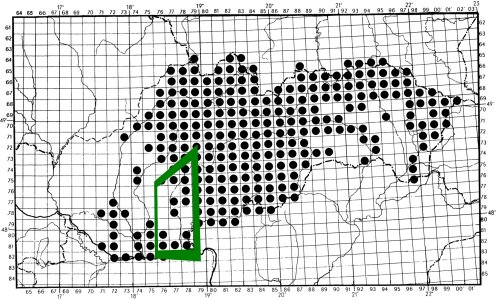 |
| Figure 3. Eurasian otter distribution in the lower parts of the Hron River catchment in 1990s (Kadlečík and Urban, 1997). Legend: black circles – occurrence of the otter; green lines – lower part of the Hron River catchment. (click for larger version) |
Although a number of studies on the distribution and ecology of the otter have been carried out concerning the Hron River catchment (e.g. Urban, 1999; Urban and Topercer, 1999; Ramaj, 2008; Urban et al., 2011) none conducted a mapping of changes in otter distribution in the entire area.
The aim of this study was to summarize and compare the results from three otter surveys in the whole Hron River catchment.
METHODS
Study area
The Hron River is one of the main rivers on the West Carpathians. It is the second longest (length 297.4 km; catchment area- 5464.54 km2), and one of the most important left side tributaries, of the Danube River in Slovakia with an average flow rate of 56 m3.s-1 near its confluence with the Danube (Figure 4). The source of the river is situated between the Nízke Tatry and Slovenský Raj Mountains at 934 m a.s.l. (Figure 5) and reaches the Danube River near the village of Kamenica nad Hronom (at 103 m a.s.l) (Figure 6). The upper and middle parts of the river lie in the submontane and colline belts of the Carpathian phytogeographical region. The lower part is situated in the planare belt of the Pannonian phytogeographical region but a major part of the river is regulated and affected by strong human activities (e.g. Urban et al., 2010b).
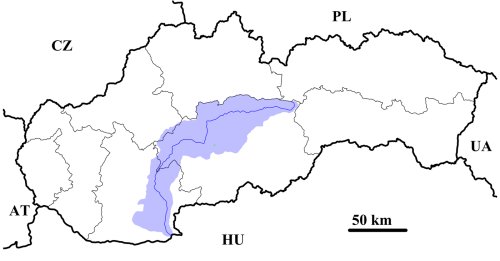 |
| Figure 4.
The Hron River catchment. [Available at: http://upload.wikimedia.org/wikipedia/commons/8/81/Hron_River_-_location_and_watershed_map.svg]. (click for larger version) |
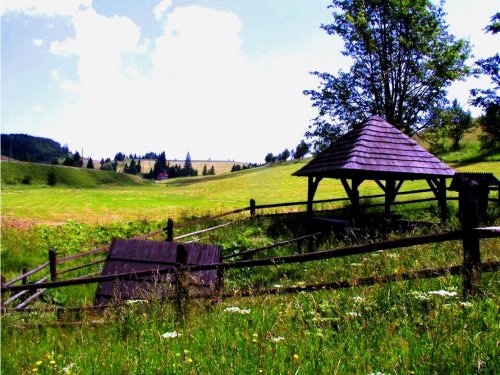 |
| Figure 5. The source of the Hron River above the Telgárt village © Peter Urban.]. (click for larger version) |
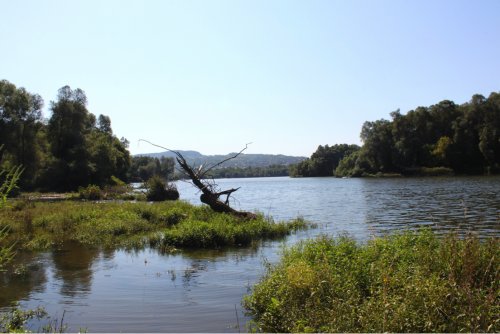 |
| Figure 6. The estuary of the Hron River in to the Danube River near Kamenica nad Hronom © Peter Urban. (click for larger version) |
In the upper part of the river, heavy industry is absent and this habitat was included in the European network of Special Areas of Conservation - Natura 2000. The Hron river is contaminated by multiple sources of geogenic and anthropogenic origin since wood, petrochemical and mining industries are located in various sites through the catchment (Hiller et al., 2010). More serious pollution begins in Brezno and comes from urban settlements, such as Brezno, Podbrezová, Dubová and Slovenská Ľupča. In the middle stretch there are not only urban agglomerations (e.g. Banská Bystrica, Zvolen), but also an industrial one (aluminium factory in Žiar nad Hronom). In the downstream stretch, the biota in the river is negatively influenced by a water power station, urban wastewaters and significant eutrophication due to agriculture (e.g. Bulánková and Némethová, 2007; Urban et al., 2010b).
Field sampling
The modified standard IUCN/OSG method for monitoring of the Eurasian otter was used for three field censuses in the Hron River catchment. This involved searching for signs of presence of this species, such as footprints, anal gland secretions and spraints in a network of UTM grid quadrates (e.g. Reuther et al., 2000). During each census, 600 m long sections in 48 quadrates of the "Databank of Slovak Fauna (DSF)"(approx. 10×12 km) were checked for otter presence. These quadrants were subdivided into a higher resolution grid of 152 smaller quadrants (approx. 2.5×3km).)
The first survey was held in winter of 1995/1996. The second survey was carried out in summer and autumn of 2010 (during the third one-off otter mapping on the whole Slovak territory, e.g. Urban 2010, Urban et al., 2010a) and the third survey was performed in winter of 2011/2012. Spraints were rated in three categories - fresh (max. up to 5 days); medium (dry but yet intact, ca 6-14 days) and old (dry, several weeks old, compact or broken into components) (Bas et al., 1984, modified by Urban and Topercer, 2001). During each survey every spraint discovered was removed.
RESULTS AND DISCUSSION
During the first survey 35 quadrants (72.9 %) and 73 quadrants (48.0 %) were positive for otter presence (Figure 7 and 8). During the second survey 45 quadrates (93.7 %) and116 quadrants (76.3%) (Figure 9 and 10). Similar to the previous mappings, the third mapping (in winter of 2011/2012) resulted in 45 positive quadrants (93.7 %) and 120 (78.9%) positive quadrants (Figure 11 and 12).
Water pollution had probably a major impact on the otter distribution and abundance in the Hron River catchment. Water quality in this river basin is largely influenced by the settlement of peoples and his lifestyle, especially by use of landscape for agricultural purposes and production of waste water in the settlements and industrial effluents and higher consumption of water resources. The Hron River was enormous permanently polluted (especially by industrial effluents) during the 1960s and 70s of the 20-th centuries. Pollution completely excludes fish life in the middle part of the river (Pekárová and Szolgay, 2005). The rapid increase of pollution in the1970s (e.g. the period 1972-1976 was consider as the upper limit of the stream pollution at sampling site Šalková, near Banská Bystrica) is followed by gradual improvement of the surface water quality in next period (Sedlár et al., 1983a,b,c; Pekárová et al., 2004). The Hron River catchment is one of the most used areas in Slovakia from the view point of water-management balance. In the second half of seventies a rapid development of industrialization and economic and urban activities affected the area of water consumption. This had negative effect on the total decrease of water bearing capacity in the entire length of the river, besides other natural impacts. The timing of permanently pollutions and water consumption correlates with the period when the otter population in Slovakia decline and indicated recent population bottleneck (Hájková, 2007; Hájková et al., 2007). The situation in the overall pollution of the Hron River in the 1980s and 1990s of the 20th century was gradually improved. Reducing the quantities of pollutants from agriculture and industry, and building of a wastewater treatment plants has improved the situation, so that through intensive restocking returned fish life in the middle Hron until Žiar nad Hronom (Pekárová and Szolgay, 2005). Fish populations have been re-established by programs of intensive stocking in the Hron River basin, principally from Podbrezová to Žiar nad Hronom (Mužík, 2013).
A similar situation was also recorded for aquatic invertebrates (e.g. Bitušík et al. 2006; Krno, 2007; Illéšová et al., 2008). Compared chironomid assemblages with data from 1980s when the zonation pattern was largely influenced by pollution stress (Bitušík, 1997), the present data support the longitudinal interpretation scheme of the river (Bitušík et al., 2006).
The upper stretch of the Hron River to Slovenská Ľupča achieves recent high or good ecological status. The middle and lower stretches of the Hron River achieve moderate ecological status as well as poor chemical status (Anonymous, 2009). In spite of the relatively high human impact in lowland part of the Hron River, habitat diversity in whole river course is still very high (Bulánková, 2006). The main pollutants in the chemical status category are phthalates - the most commonly used plasticizers and lead (Pb). The majority of water bodies in the river basin (73.0 %) achieve good or high ecological status, only 27.0 % of the water bodies in the river basin are failing to achieve good status (Anonymous, 2009).
In general, otter abundance and densities are higher, while their homerange sizes are inversely related to the river width (Sidorovich et al., 1996; Ó Néill et al., 2009; Romanowski et al., 2013), which is mainly a consequence of the higher fish productivity in larger rivers. In very small watercourses, otters are usually only occasional visitors (Romanowski et al., 2013).
A new survey conducted in the Hron River catchment, in 2008-2010, revealed that seasonal distribution of spraint numbers was bimodal, showing a maximum in autumn and spring and the minimum in the summer. Of the 180 habitat variables sampled at 137 sites, multiple logistic regression indicated positive relationships between spraint numbers and otter distribution with the percentage of stones suitable for sprainting in the channel, distance to the nearest human settlement, and negative relationships to the average depth and width of the channel, percentage of trees in the riparian vegetation and intensity of human intrusions. The strength and significance of all relationships varied seasonally, most markedly with stream the velocity and the percentage of trees in the riparian vegetation (Urban et al., in prep.). Riparian vegetation and habitat quality is one of the most important drivers of the large-scale recovery of the otter for several reasons: it provides resting and breeding dens, provides cover during movements, enhances filtering of pollutants, and promotes fish productivity (e. g. Jenkins and Burrows, 1980; Green et al., 1984; Elmeros et al., 2006; Clavero et al., 2010; Romanowski et al., 2013).
The main food source for otters is fish, which differ in composition between the upper and the lower section of the river, yet species richness is similar (e. g. Kruuk et al., 1993; Jeņdrzejewska et al., 2001; Lanszki and Sallai, 2006; Loy et al., 2009; Urban et al., 2010b).
The major constraint on otter populations in West Sussex was food availability with fish and amphibians forming the major part of their diet (e.g. Kruuk et al., 1988; Jacobsen and Hansen, 1996; Chanin, 2003). Fish and eel movements along the river were hindered by barriers such as weirs (King, 2011). Until the turn of the century, on the main flow of the Hron River there were already a small number of barriers, such as weirs (e.g. Lopej, Zvolen) and dams (the Veľké Kozmálovce reservoir with an area of 0.62 km2 and a total water volume of 2.7×106 m3) (Figure 13). In the last 20 years about 10 new small hydropower plants have been built (Figure 14). In the Hron River were 22 transverse structures without fishpass in operation in 2009 and the construction of 30 new small hydropower plants on the Hron River is being considered.
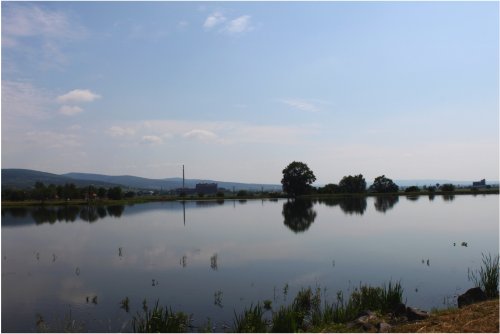 |
| Figure 13. Veľké Kozmálovce water reservoirs © Peter Urban. (click for larger version) |
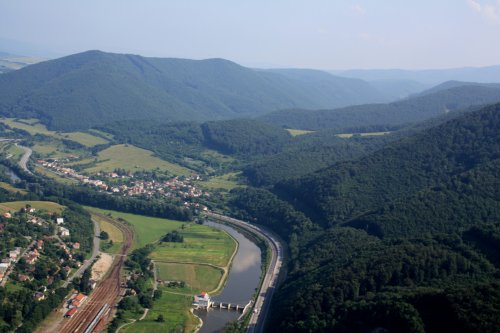 |
| Figure 14. Hronská Dúbrava small hydroelectric power plant was built in 2011 © Peter Urban (click for larger version) |
The Environmental Impact Assessment (EIA) in the Slovak Republic is carried out since 1994, when the Act No. 127/1994 Coll on EIA came into effect. In 2006 it was replaced with the Act No. 24/2006 Coll on EIA. The Eurasian Otter is listed in Annex II and IV of the Habitats Directive 92/43/EEC that involves obligations to developers within the EU. According to the Habitats Directive the otter population and its habitats, including corridors connecting local populations, must be considered in the EIA throughout the EU territory and not only in the Special Areas of Conservation (SACs). In most EIA projects there were no proposed mitigation or compensation measures designed particularly for otters, and there were no studies dealing with otters. In the future it will be needed to make the EIA process in Slovakia more appropriate, inter alia, with regard to otters and other animal species (Urban et al., 2010a).
Recent studies indicate that the recovery of the otter is accompanied by a change in habitat selection (e.g. Romanowski, 2006; Clavero et al., 2010). Habitat features that limit the species expansion are, amoung others, the presence of large towns or hydroelectric dams, and important reduction of the river flow, (e. g. Ruiz-Olmo et al., 1991; Saavedra 2002). In the middle flow of the Hron River is the conurbation Banská Bystrica (ca. 80.000 people) - Zvolen (ca. 70.000 people). In both cities, the river was regulated, but the otter occurs throughout the year.
In general, otter were seen to re-colonize habitats with low quality too, such as regulated river sections, river sections in agricultural landscape with large blocksof fields, or in industrialized areas (e. g. Green and Green, 1997; Romanowski, 2006, Romanowski et al, 2013). In the Hron River catchment area 137 localities were checked (Figure15). These, fell into 17 different CORINE land cover classes out of the 31 landclasses which were identified for the entire territory of Slovakia (Feranec and Oťahel, 2001). The most representative types were the Discontinuous urban fabric (25 localities, 18.3%), Broad-leaved forests (16 localities, 11.7%) and Coniferous forests (11 localities, 8.0%) (Urban et al., in prep.). Similar results were obtained from Scotland, where an increasing otter population recolonized a relatively polluted and industrialized area (Green and Green, 1997) and in Poland where otters were often detected in low-quality habitats (e. g., regulated river sections) (Romanowski et al., 2013). Wide distribution of otter signs in various types of riparian habitats, including those strongly transformed by human activity, may be an indicator of a thriving and numerous population (Baltrūnaitė et al., 2009).
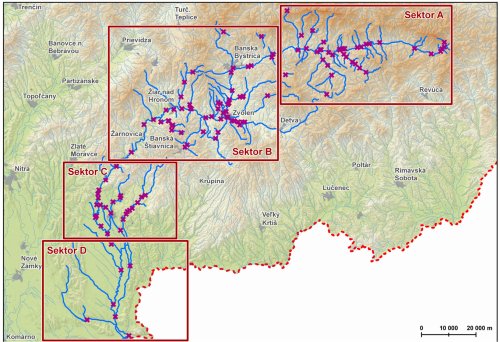 |
| Figure 15. Overview of checked localities in the Hron river catchment. Author of the map © Michal Klaučo (click for larger version) |
The negative side-effect of the otter expansion is the increase of fish-stock damages in the Hron River and its tributaries as well as in small fish ponds located in the catchment. As a consequence, fishpond owners are increasingly seeking damage compensation or permits for shooting otters (similar to the cormorant, Phalacrocorax carbo). Information about the impact of otters on fish assemblages and stocks is therefore of considerable interest especially to ichthyologists and nature conservationists.
Problems, which are connected to the occurrence of the otter and fishery, are becoming increasingly important (Kučerová et al., 1996). One of the reasons, why this is so, is the increasing density of otter populations and recolonisation of the habitats, mainly in areas with ponds (e.g. Kemenes and Nechay, 1990; Kemenes, 1991; Bodner, 1995a) and along rivers, which are used by fishing organisations (e. g. Carss et al., 1990; O’Neill, 1998; Ludwig et al., 2002; Poledník et al., 2004 ). The recent increase in otter numbers has resulted in a typical human-wildlife conflict due to significant damages by otter spredating on commercial fishstocks, particularly at farmed fishponds (e.g. Kloskowski, 2005; Kranz et al., 1999; Myšiak et al., 2004). Eurasian otter and managed fisheries in Central Europe, mostly carp (Cyprinus carpio) production, is another example of a widely studied conflict, focusing on otter diet (e.g. Bodner, 1995a,b; Kučerová 1996, 1998; Gossow and Kranz, 1998; Kloskowski, 1999, 2000a,b, 2005; Adámek et al., 2003; Lanszki and Molnár, 2003; Lanszki et al., 2001; Jacobsen, 2005; Poledník, 2005; Baltrūnaitė, 2009; Kloskowski 2011), biological indicators of stress (e.g. Poledník et al., 2008), damage assessment (e.g. Skaren, 1990; Bodner, 1995b, 1998; Gossow and Kranz, 1998; Kloskowski, 2005; Poledník, 2005), damage prevention (e.g. Bodner, 1995b; Gossow and Kranz, 1998; Leblanc, 2003; Kloskowski 2011; Klenke et al., 2013; Poledníková et al., 2013) and compensation schemes (e.g. Gossow and Kranz, 1998; Freitas et al., 2007; Schwerdtner and Gruber, 2007; Kloskowski 2011; Václavíková et al., 2011; Poledníková et al., 2013; Santos-Reis et al., 2013; Klenke et al., 2013). This type of biological and socio-economic information is critical for rescue management, conflict resolution and species conservation (Sales-Luis et al., 2009). Damage compensation schemes are widely used to mitigate human–wildlife conflicts. Despite the growing relevance of such conflicts, a theoretical framework to analyze the cost-effectiveness of damage compensation schemes is still missing (e.g. Schwerdtner and Gruber, 2007).
Compensation of damages caused by otters in the Slovak Republic is legally established in the Act No. 543/2002 on Nature and Landscape Protection and in the Decree No. 24/2003 to this act. According to this Act the state is responsible for damages caused by otters on the fish raised for commercial purposes in fishponds or in aquaculture facilities. It is possible to provide compensation if the otter probably occurs at the time and place of the recorded damages. Funding for compensations is provided by the Ministry of Environment of the Slovak Republic from the state budget through the Regional Offices of Environment. According to the Act no. 543/2002 on nature and landscape protection it is not possible to enforce the compensation of damages in open waters. However there is increasing pressure from the Slovak Anglers Association (Slovenský rybársky zväz) to deal with the problem of fishery in mountain and submountain rivers and streams (trout waters) with otters
Fishermen also claim that the reintroduction of otters by nature conservation (state organisations and NGO-s too) helps its spread in the Hron River. Reintroductions of extinct or endangered and nearly extinct species are becoming nowadays a more accepted tool for the restoration of biodiversity (Seddon, 2010). Reintroduction of otters supports otter conservation as confirmed by the results of discussions and controversies some time ago (e.g. De Jongh, 1998; Reuther, 1998). The reintroduction through translocation of wild animals has been chosen because it is desirable (IUCN, 1998). In Europe, reintroduction programs of the Eurasian otter started in the 1980s in England (lowland English rivers: Jefferies et al., 1986, 2000; Wayre, 1989, 1992; Jessop and Cheyne, 1992; Strachan and Jefferies, 1996; Copp and Roche, 2003; White et al., 2003) and Sweden (Sjöåsen and Sandegren, 1992; Sjöåsen, 1996, 1997), where newly established populations seemed to be spreading. More recently, the otter has been successfully reintroduced in some countries. We have examples of this in the Czech Republic (Jeseníky Mts.: Hlaváč et al. 1998; Toman et al., 2003; Poledníková et al., 2010), France (Rosoux et al., 1996; Fidenci, 2010), Italy (Ticino River: Prigioni, 1995; Prigioni et al., 2009), the Netherlands (Lammertsma et al., 2006; Koelewijn et al., 2010; Seignobosc et al., 2011) and north-eastern Spain (Girona’s province: Saavedra and Sargatal, 1998; Mateo et al., 1999; Fernández-Morán et al. 2002; Saavedra, 2002; Ferrando et al., 2008). In West European countries, reintroduction programs in the areas where otters have been extinct are developed after restoration of natural otter habitats and improving water quality (Koelewijn et al., 2010; Romanowski et al., 2013).
In the Czech Republic the otter was reintroduced in the Jeseníky Mountains in 1994–2003. The aim was to connect the south-Bohemian population with the strong Slovak or “east-European” population and thus prevent possible decrease in genetic variability in the future (Hlaváč, 1995; Hlaváč et al., 1998). After the introduction of legislative protection, several management actions and general improvement of riverine habitats, the otter population has recovered and the species currently occupies most of its historical range (Poledník et al., 2007).
In Slovakia, reintroduction of otters has not yet been carried out, because it was not necessary and otters naturally colonized not only Hron River, but also other rivers, especially their middle sections. However, otter shave been released into the wild after successful rehabilitation in a few cases (e.g. in Váh and Orava rivers - in northern Slovakia).
The negative attitude towards otters persists and their illegal killing remains a common practice in Slovakia. Despite the general prohibition of hunting protected animals in Slovakia the cases of shooting, striking death or catching otters in traps or fyke nets are also common and an indication of insufficient public awareness (Urban et al., 2010a). With the increased economical use of waters the otter has become understood as a competitor to man and the voices for the control of its population have been raised. This supports poaching, the extent of which however is difficult to assess (Kadlečík, et al. 2009; Urban et al., 2010a). With the increased economical use of waters, the otter has become identified as a competitor to man and voices for the control of its population have been raised. This supports poaching, the extent of which, however, is difficult to assess (Kadlečík et al., 2009).
Otter road kills are currently among the most important recorded reasons of its mortality in the Hron River catchment. For example, in the sections of the I. class road between Banská Bystrica and Brezno as well as Brezno and Telgárt (ca 90 km), along the upper Hron River, we registered 23 killed otters between 2005-2010 (Urban et al., 2011).
The otter is in the Hron River catchment protected in 11 Special Areas of Conservation (Natura 2000) - in both biogeographical Regions in Slovakia (Alpine and Pannonian): Alúvium Hrona, Pohorelské vrchovisko, Bacúšska jelšina, Kráľovohoľské Tatry, Ďumbierske Tatry, Veľká Fatra, Vtáčnik, Skalka, Suť, Klokoč, Hodrušská hornatina, 3 national parks (Nízke Tatry, Muránska planina and Veľká Fatra) and 3 protected landscape areas (Poľana, Štiavnické vrchy, Ponitrie). To protect the habitats of otters some small-scale protected areas have been designated, e.g. Protected Site (PS) Kamenistý potok.
Other protected areas, set up to protect valuable wetland communities and localities, include the most valuable sections of the otter home range, e.g. National Nature Reserve (NNR) Meandre Hrona and Parížske močiare.
Concluding remarks
Answer to the question who reintroduced the Otter in the Hron River and why is very easy and briefly: nobody, because it was not necessary. The otter has expanded its distribution range in the Hron River catchment in the last two decades. This spread probably related with improvement of the surface water quality in 1980s and 1990s and with the overall increase in species range and numbers of otters in other parts of Slovakia, simultaneous to the similar recolonization processes in several European (and neighboring) countries (e.g. Kranz et al., 2001; Prigioni et al., 2007; Poledníková et al., 2010; Romanowski et al., 2013).
However, as the West Carpathian and Hercynian otter populations experienced a population decline of unknown extent over the past century, their genetic polymorphism and effective population size may have been depleted, making them vulnerable to any strong demographic change (Hájková et al., 2007).
Acknowledgements - I would like to thank to colleagues and students, Martin Benda, Peter Bitušík, Anton Krištín, Zuzana Kubíková, Dušan Malatinec, Stanislav Ondruš, Erika Urbanová, Ivan Valach, for their assistance, or help with the fieldwork. I also thank to Ľubomír Repiský and Michal Klaučo for preparation of maps. I am grateful to Ladislav Hamerlík for proofreading. This study was supported by the VEGA Grant Agency of the Slovak Republic (grant numbers 1/0836/08 and 2/5083/25) and KEGA Grant Agency of the Slovak Republic (grant number KEGA 001UMB-4/2012).
REFERENCES
Adámek, Z., Kortan, D., Lepic, P., Andreji, J. (2003). Impacts of otter (Lutra lutra) predation on fishponds: a study of fish remains at ponds in the Czech Republic. Aquaculture 11: 389-396.
Anonymous (2009). Status of waters and water management issues in the River basins of the Slovak Republic. Water Research Institute, Bratislava.
Baltrūnaitė, L. (2009). Diet of Otters in Fish Farms in Lithuania. Acta Zoologica Lituanica19(3): 182-187.
Baltrūnaitė, L., Balčiauskas, L., Matulaitis, R., Stirkė, V. (2009). Otter distribution in Lithuania in 2008 and changes in the last decade. Estonian Journal of Ecology 58: 94–102.
Bas, N., Jenkins, D., Rothery, P. (1984). Ecology of otters in northern Scotland. The distribution of otter (Lutra lutra) faeces in relation to bankside vegetation on the river Dee in summer 1981. Journal of Applied Ecology 21(2): 507-513.
Bel, M. (1736). Notitia Hungariae novae historico–geographica. Tomus II. J.P. van Ghelen, Vienna. [Available at: http://oldbooks.savba.sk/digi/].
Bitušík, P. (1997). The use of chironomid pupal exuviae (Diptera: Chironomidae) for characterizing of the river Hron (Slovakia, West Carpathians). Acta Facultatis Ecologiae 4: 61-76.
Bitušík, P., Svitok, M., Dragúňová, M. (2006). The actual longitudinal zonation of the river Hron (Slovakia) based on chironomid assemblages (Diptera, Chironomidae). Acta Universitatis Carolinae Biologica 50: 5-17.
Bodner, M. (1995a). Fish loss in Austrian fish-pond as result of otter (Lutra lutra) predation. IUCN
Otter Spec. Group Bull.12: 3–10.
Bodner, M. (1995b). Otters and fish-farming: preliminary experiences of a WWF project in Austria. Hystrix 7(1-2): 223–228.
Bodner, M. (1998). Damage to stock in fish ponds as a result of otters (Lutra lutra) predation. BOKU-Reports on Wildlife Research & Game Management 14:106-117.
Bulánková, E. (2006). Hodnotenie riečnej morfológie Hrona pomocou metódy River Habitat Survey. Acta Fac. Ecol. 14: 39–45.
Bulánková, E., Némethová, D. (2007). Linkages between Land-Use, Water Quality, Physical Habitat Conditions and Selected Macroinvertebrate Assemblages of the Hron River (Slovakia). Acta Universitatis Carolinae Environmentalica 21 (2007): 35-46.
Carss, D.N., Kruuk, H., Conroy, J.W.H. (1990). Predation on adult Atlantic salmon, Salmo salar L., by otters, Lutra lutra L., within the River Dee system, Aberdeenshire, Scotland. Journal of Fish Biology37: 935-944.
Chanin, P. (2003). Ecology of the European Otter (Lutra lutra): Conserving Natura 2000 Rivers. Ecology Series No. 10. English Nature, Peterborough.
Chudík, I. (1969). Príspevok k poznaniu rozsiahlosti lovišťa vydry riečnej na horských riekach Slovenska. Československá ochrana prírody. 8: 149-158.
Clavero, M., Hermoso, V., Brotons, L., Delibes, M. (2010). Natural, human and spatial constraints to expanding populations of otters in the Iberian Peninsula. J. Biogeogr. 37: 2345-2357.
Copp, G. H., Roche, K. (2003). Range and diet of Eurasian otters Lutra lutra (L.) in the catchment of the River Lee (south-east England) since re-introduction. Aquatic Conservation: Marine and Freshwater Ecosystems13(1): 65-76.
De Jongh, A.W.J.J. (1998). Re-introduction of otters - support or risk for otter conservation? IUCN Otter Spec. Group Bull. 15: 80-86.
Elmeros, M., Hammershøj, M., Madsen, A.B., Søgaard, B. (2006). Recovery of the otter Lutra lutra in Denmark monitored by field surveys and collection of carcasses. Hystrix. It. J. Mamm. (n. s.) 17: 17-28.
Feranec, J., Oťahel, J. (2001). Krajinná pokrývka Slovenska. Land cover of Slovakia. Veda, Bratislava.
Ferianc O. 1949. Fauna Zvolenskéhookresu so zreteľom na stavovce. Prírodvedný sborník SAV, Bratislava. 4: 37-76.
Feriancová–Masárová, Z., Hanák, V. (1965). Stavovce Slovenska 4. Cicavce.Vydavateľstvo Slovenskej akadémie vied, Bratislava.
Fidenci, P. (2010). A slow comeback for the endangered Eurasian otter in France. Mongabay.
[Available at: http://news.mongabay.com/2010/0829-fidenci_otters.html].
Fernández-Morán J., Saavedra, D., Manteca-Vilanova, X. (2002). Reintroduction of the Eurasian otter (Lutra lutra) in northeastern Spain: trapping, handling, and medical management. Journal of Zoo and Wildlife Medicine 33(3): 222-227.
Ferrando, A., Lecis, R., Domingo-Roura, X., Ponsà, M. (2008). Genetic diversity and individual identification of reintroduced otters (Lutra lutra) in north-eastern Spain by DNA genotyping of spraints. Conservation Genetics9(1): 129-139.
Freitas, J., Gomes, J., Sales Luis, T., Madruga, L., Marques, C., Baptista, G., Rosalino, L. M., Antunes, P., Santos, R., Santos-Reis, M. (2007). Otters and fish farms in the Sado estuary: ecological and socio-economic basis of a conflict. Hydrobiologia
587 (1): 51-62.
Gossow, H., Kranz, A. (eds.). (1998). Otters and Fish Farms. Proceedings International Workshop Litschau, 8.-9. Feb. 1996 (Austria). Boku-Reports on Wildlife Research & Game Management 14: 1-144 pp.
Green, J., Green, R., Jefferies, D.J. (1984). A radio-tracking survey of otters Lutra lutra on a Perthshire river system. Lutra 27: 85-145.
Green, R., Green, J. (1997). Otter survey of Scotland 1991–94. Vincent Wildlife Trust, London.
Hájková, P. (2007). Genetická štruktúra a recentný pokles početnosti populácií vydry riečnej v ČR a SR. Bulletin Vydra 14: 50–57.
Hájková, P., Pertoldi, C., Zemanová, B., Roche, K., Hájek, B., Bryja, J., Zima J. (2007). Genetic structure and evidence for recent population decline in Eurasian otter populations in the Czech and Slovak Republics: implications for conservation. Journal of Zoology, London 272: 1-9.
Hell, P. (1980). Die Situation des Fischotters in der ČSSR. pp. 195–198. In: Reuther, C., Festetics, A.(eds.): Der Fischotter in Europe. Verbreitung, Bedrohung, Erhaltung. Ergebnisse des I. Internationalen Fischotter-Kolloquiums vom 28. bis 31. Oktober 1979 in Göttingen. Selbstverlag, Oderhaus und Göttingen.
Hell, P., Cimbal, D. (1978). Rozšírenie a početnosť vydry riečnej (Lutra lutra L.) na Slovensku. Folia venatoria 8: 223-236.
Hiller, E., Jurkovič, Ľ., Šutriepka, M. (2010). Metals in thre Surface Sediments of Selected Water Reservoirs, Slovakia. Bull. Environ. Contam.Toxicol. 84: 635-640.
Hlaváč, V. (1995). Příprava reintrodukčního projektu v oblasti Jeseníků. Bulletin Vydra 5: 2–3.
Hlaváč, V., Toman, A., Boděšínský, M. (1998). Experimentální reintrodukce vydry v Jeseníkách. Bulletin Vydra 8: 27-39.
Illéšová, D., Halgoš, J., Krno, I. (2008). Blackfly assemblages (Diptera, Simuliidae) of the Carpathian river: habitat characteristics, longitudinal zonation and eutrophication. Hydrobiology 598(1): 163-174.
IUCN (1998). IUCN Guidelines for re-introductions. Gland, Switzerland.
Jacobsen, L. (2005). Otter (Lutra lutra) predation on stocked brown trout (Salmo trutta) in two Danish lowland rivers. Ecology of Freshwater Fish 14(1)0: 59-68.
Jacobsen, L., Hansen, H.M. (1996). Analysis of otter (Lutra lutra) spraints: Part 1: Comparison of methods to estimate prey proportions; Part 2: Estimation of the size of prey fish. Symp. Zoological Society London 238: 167-180.
Jamnický, J. (1995). Lov vydry riečnej (Lutra lutra L.) na Slovensku pred sto rokmi. Folia Venatoria 25: 189-194.
Jefferies, D. J., Wayre, P., Jessop, R. M., Mitchell-Jones, A. J. (1986). Reinforcing the native otter Lutra lutra population in East Anglia: an analysis of the behaviour and range development of the first release group. Mammal Rev. 16: 65-79.
Jefferies, D. J., Wayre, P., Shuter, R. (2000). A brief history of the Otter Trust’s successful programme of repopulating lowland England with otters bred in captivity with a special emphasis on East Anglia. Otters, Journal of the Otter Trust 3(4): 105-117.
Jeņdrzejewska, B., Sidorovich, V. E., Pikulik, M. M., Jeņdrzejewski, W. (2001). Feeding habits of the otter and American mink in Białowieża Primeval Forest (Poland) compared to other Eurasian populations. Ecography 24: 165-180.
Jenkins, D., Burrows, G. O. (1980). Ecology of otters in northern Scotland. 3. The use of faeces as indicators of otter (Lutra lutra) density and distribution. J. Anim. Ecol. 49: 755-774.
Jessop, R.M., Cheyne, D.L. (1992). The re-introduction of the European otterLutra lutra in to Lowland England carried out by the Otter Trust 1983-92. A progress report. Proceeding of the National Otter Conference, Cambridge, September, 1992, pp: 12-16.
Jirsík, J. (1926). Přehled slovenských savců. Věstník Československé společnosti zemědělských věd 30: 1-8.
Kadlečík, J. (1990a). Akcia Vydra a jej poslanie. Bulletin Vydra 1: 3-9.
Kadlečík, J. (1990b). Zahájenie Akcie Vydra. Bulletin Vydra 1: 10-12.
Kadlečík, J. (1992). Rozšírenie vydry riečnej (Lutra lutra L., 1758) na Slovensku - súčasný stav poznania. Bulletin Vydra 3: 54-59.
Kadlečík, J. (1998). Poznámky k rozšíreniu vydry riečnej (Lutra lutra) v oblastiach priľahlých k riekam Morava a Dunaj v rokoch 1994-1998. Bulletin Vydra, 8: 17-22.
Kadlečík, J., Urban, P. (1997). Vydra riečna (Lutra lutra L.) na Slovensku a jej ochrana. Folia venatoria 26–27: 111-129.
Kadlečík, J., Urban, P., Kadlečíková, Z., Adamec, M. (2009). Program záchrany vydry riečnej (Lutra lutra Linnaeus, 1758). Aktualizácia pre obdobie rokov 2009 – 2013. ŠOP SR, Banská Bystrica (msc.). [Depon. In: State Nature Conservancy of the Slovak Republic, Banská Bystrica].
Kemenes, I. (1991). Otter distribution, status and conservation problems in Hungary. IUCN Otter Spec. Group Bull.6: 20–23.
Kemenes, I., Nechay, G. (1990). The food of otters (Lutra lutra) in different habitats in Hungary. Acta Theriologica 35(1–2): 17–24.
King, P. (2011). Routes of recolonisation of the Eurasian otter (Lutra lutra) into West Sussex: An investigation of optimum ways to restore a viable ecological network to assist their recovery to the South East, with particular reference to the Western Rother Valley. People´s trust for endangered species.
Klenke, R. A., Ring, I., Kranz, A., Jepsen, N., Rauschmayer, F., Henle, K. (2013). Human - Wildlife Conflicts in Europe Fisheries and Fish-eating Vertebrates as a Model Case. Springer, Heidelberg, New York, Dordrecht, London.
Kloskowski, J. (1999). Otter Lutra lutra predation in cyprinid-dominated habitats. Zeitschrift für Säugetierkunde 64: 201-209.
Kloskowski, J. (2000a). Selective predation by otters Lutra lutra on common carp Cyprinus carpio at farmed fisheries. Mammalia, 64: 287-294.
Kloskowski, J. (2000b). The distribution of otter Lutra lutra spraints in relation to habitat exploitation in a fish-pond area, South-East Poland. Lutra, 43:19-28.
Kloskowski, J. (2005). Otter Lutra lutra damage at farmed fisheries in southeastern Poland, II: exploitation of common carp Cyprinus carpio. Wildlife Biology 11: 257-261.>
Kloskowski, J. (2011). Human–wildlife conflicts at pond fisheries in eastern Poland: perceptions and management of wildlife damage. European Journal of Wildlife Research,57(2): 295-304.
Koelewijn, H.P., Pérez-Haro, M., Jansman, H.A.H., Boerwinkel, M.C., Bovenshen, J., Lammertsma, D.R., Niewold, F.J.J., Kuiters, A.T. (2010). The reintroduction of the Eurasian otter (Lutra lutra) into the Netherlands: hidden life revealed by noninvasive genetic monitoring. Conserv. Genet.11: 601–614.
Kornhuber, G. A. (1857). Synopsis der Säugethiere mit besonderer Beziehung auf deren Vorkommen in Ungarn. Druck von K. F. Wigand, Presburg.
Kranz, A. (1999). Re-Introduction of Otters: A Reply. IUCN Otter Spec. Group Bull. 16 (1): 8-10.
Kranz, A., Polednik, L., Pinter, V., Parz-Gollner, R. (2001). Distribution, status and conservation of otters in Lower Austria. Wiss. Mitt. Niederösterr. Landesmuseum14: 39-50.
Krno, I. (2007). Impact of human activities on stonefly (Insecta, Plecoptera) ecological metrics in the Hron River (Slovakia). Biologia, Bratislava, 62(4): 446-457.
Kruuk, H., Carss, D.N., Conroy, J.W.H., Gaywood, M.J. (1988). Habitat use and conservation of otters Lutra lutra in Britain: a review. Symp. Zoological Society London 71: 119-134.
Kruuk, H., Carss, D. N., Conroy, J. W. H., Durbin, L. (1993). Otter (Lutra lutra) numbers and fish productivity in rivers in North-East Scotland. Symp. Zoological Society London 65: 171–191.
Kučerová, M. (1996). Economic damages caused by otters. pp. 97–103. In: Dulfer, R., Roche, K. (eds), First phase report of the Třeboň Otter Project. Nature and Environment 93: 1-141.
Kučerová, M. (1998). Diet and damages by otters Lutra lutra on a series of private ponds in southern Bohemia (Czech Republic). Pp. 83–88. In: Gossow, H., Kranz, A. (eds.), Otters and Fish Farms. Proceedings International Workshop Litschau, 8.-9. Feb. 1996 (Austria). Boku-Reports on Wildlife Research & Game Management 14: 1-144 pp.
Lammertsma, D., Niewold, F., Jansman, H.,Kuiters, L., Koelewijn, H. P., Perez Haro,M., van Adrichem, M., Boerwinkel, M. C., Bovenschen, J. (2006). Herintroductie van de otter: eensucces verhaal? De Levende Natuur 107: 42-46.
Lanszki, J., Molnár, T. (2003). Diet of otters in three different habitats in Hungary. Folia Zoologica 52: 378–388.
Lanszki, J., Sallai, Z. (2006). Comparison of the feeding habits of Eurasian otters on a fast flowing river and its backwater habitats. Mamm. Biol. 71: 336-346.
Lanszki, J., Körmendi, S., Hancz, C., Martin, T.G. (2001). Examination of some factors affecting selection of fish prey by otters (Lutra lutra) living by eutrophic fish ponds. Journal of Zoology (London) 255: 97-103.
Leblanc, F. (2003). Protecting fish farms from predation by Eurasian otter (Lutra lutra) in the Limousin region of central France: first results. IUCN Otter Spec. Group Bull.20(1):45-48.
Loy, A., Carranza, M. L., Cianfrani, C., D’Alessandro, E., Bonesi, L., Di Marzio, P., Minotti, M., Reggiani, G. (2009). Otter Lutra lutra population expansion: assessing habitat suitability and connectivity in southern Italy. Folia Zool .58 (3): 309-326.
Ludwig, G.X., Hokka, V., Sulkava, R., Ylönen, H. (2002). Otter Lutra lutra predation on farmed and free-living salmonids in boreal freshwater habitats. Wildl. Biol.8: 193-199.
Mateo, R., Saavedra, D., Guitart, R. (1999). Reintroduction of the Otter (Lutra lutra) into Catalan Rivers, Spain: Assessing Organochlorine Residue Exposure Through Diet. Bulletin of Environmental Contamination and Toxicology63(2): 248-255.
Mužík, V. (2013). Slovakia – factors influencing recreational fisheries.
[Available at: http://www.fao.org/docrep/005/w0318e/W0318E15.htm].
Myšiak, J., Schwerdtner, K., Ring. I. (2004). Comparative analysis of the conflicts between carp pond farming and the protection of otters (Lutra lutra) in Upper Lusatia and South Bohemia. UFZ-Discussion Papers. Department of Economics, Sociology and Law (OEKUS). UFZ Centre for Environmental Research Leipzig-Halle GmbH.
O’Neill, E.M., Day, K.R., Paterson, J.P.H. (1998). Predation by otters (Lutra lutra) at a salmon hatchery, evidenced by diet studies. Boku-Reports on Wildlife Research & Game Management14: 46-64.
Ó Néill, L., Veldhuizen, T., de Jongh, A., Rochford, J. (2009). Ranging behaviour and socio-biology of Eurasian otters (Lutra lutra) on lowland mesotrophic river systems. Eur. J. Wildl. Res. 55: 363–370.
Pekárová, P., Szolgay, J. (2005). Scenáre zmien vybraných zložiek hydrosféry a biosféry v povodí Hrona a Váhu v dôsledku klimatickej zmeny. Veda, vydavateľstvo SAV, Bratislava.
Pekárová, P.,Miklánek, P., Rončák, P., Adámková, J., Chriašteľ, R., Metelková, M., Pekár, J. (2004). Identification and assessment of long-term trends of surface water quality determinands in Slovakia for implementation of the EU WFD. J. Hydrol. Hydromech. 52(4): 317-328.
Petricskó, J. (1892). Selmeczbánya vidéke állattani tekintetben. (Selmeczbánya monografiája, Természettudományi rész II. füzet). Selmeczbánya.
Podhradský, V. (1964). Na záver ankety o výskyte vydry na Slovensku. Poľovníctvo a rybárstvo 16: 15-16.
Poledník, L. (2005). Otters (Lutra lutra L.) and fishponds in the Czech Republic: interactions and consequences. PhD. thesis. Department of zoology and anthropology, Faculty of Science, Palacky University Olomouc, 109 pp. (msc.). [Depon. In: Faculty of Science, Palacky University Olomouc ].
Poledník, L., Poledníková, K., Hlaváč, V. (2007). Rozšíření vydry říční (Lutra lutra) v České republice v roce 2006. Bulletin Vydra14: 4-6.
Poledník, L., Mitrenga, R., Poledníková, K., Lojkásek, B. (2004). The impact of methods of fishery management on the diet of otters (Lutra lutra). Folia zoologica53: 27-36.
Poledník, L., Řehulka, J., Kranz, A., Poledníková, K., Hlaváč, V., Kazihnitková, H. (2008). Physiological responses of over-wintering common carp (Cyprinus carpio) to disturbance by Eurasian otter (Lutra lutra). Fish Physiology and Biochemistry
34(3): 223-234.
Poledníková, K., Poledník, L., Hájková, P., Zemanová, B., Větrovcová, J., Hlaváč, V., Beran, V., Čamlík, G., Mináriková, T. (2010). Struktura, dynamika a růst populace vydry říční (Lutra lutra L.) v České republice. Projekt SP/2d4/16/08. Unpubl. Report. Ministry of Environment, Praha.
Poledníková, K., Kranz, A., Poledník, L., Myšiak, J. (2013). Otters Causing Conflicts. pp. 81-106. In: Klenke, R.A., Ring, I., Kranz, A., Jepsen, N., Rauschmayer, F., Henle, K. (eds.), Human - Wildlife Conflicts in Europe.Fisheries and Fish-eating Vertebrates as a Model Case.Springer, Heidelberg, New York, Dordrecht, London.
Prigioni, C. (1995). Guidelines for the feasibility study of reintroduction of the otter Lutra lutra in Italy: the project of the Ticino Valley (north-western Italy). In: Prigioni C. (ed.), Proc. II It. Symp. on Carnivores, Hystrix It. J. Mamm. (n.s.) 7 (1-2): 225-264.
Prigioni, C., Balestrieri, A., Remonti, L. (2007). Decline and recovery in otter Lutra lutra populations in Italy. Mammal. Rev. 37: 71-79.
Prigioni, C., Smiroldo, G., Remonti, Balestrieri, A. (2009). Distribution and diet of reintroduced otter (Lutra lutra) on the River Ticino (NW Italy). Hystrix It. J. Mamm. (n.s.) 20 (1): 45-53.
Ramaj, M. (2008). Monitoring vydry riečnej (Lutra lutra) na vybraných tokoch Národného parku Nízke Tatry, stredné Slovensko (Carnivora: Mustelidae). Lynx (Praha), n. s.,39 (1): 129–142.
Reuther, C. (1998). Re-introduction of otters - support or risk for otter conservation?IUCN Otter Spec. Group Bull. 15: 71-79.
Reuther, C., Dolch, D., Green, R., Jahrl, J., Jefferies, D., Krekemeyer, A., Kucerova, M., Madsen, A.B., Romanowski, J., Roche, K., Ruiz-Olmo, J., Teubner, J. and Trinidae, A. (2000). Surveying and monitoring distribution and population trends of the European otter (Lutra lutra). Habitat 12: 1-148.
Romanowski, J. (2006). Monitoring of the otter recolonisation of Poland. Hystrix. It. J. Mamm. (n.s.) 17: 37-46.
Romanowski, J., Brzeziński M., Żmihorski, M. (2013). Habitat correlates of the Eurasian otter Lutra lutra recolonizing Central Poland. Acta Theriologica 58:149-155.
Rosoux, R., Tournebize, T., Maurin, L., Bouchardy, C. (1996). Étude de la répartition de la loutre d'Europe (Lutra lutra) en France. Actualisation 1993. In: La Loutre et le Vison d'Europe. (Edited by Gautier, J.Y., Libois, R., Rosoux, R.) (Proceedings of the XVIIth International Mammalogical Conference, Niort, 23-25 October 1993.) Cahiers d'Ethologie appliqué, 15: 195-206.
Ruiz-Olmo, J., Jimenez, J., Lacomba, I. (1991). Length of hydrographical basins
and population viability of the otter in rivers in Eastern Spain. Habitat 6: 255-258.
Saavedra, D. (2002). Reintroduction of the Eurasian otter (Lutra lutra) in Muga and Fluvià basins (north-eastern Spain): viability, development, monitoring and trends of the new population. PhD Thesis, Girona, University, 217 pp.
Saavedra, D., Sargatal, J. (1998). Reintroduction of the otter (Lutra lutra) in northeast Spain (Girona Province). Galemys
10:191–199.
Sales-Luis, T., Freitas, D., Santos-Reis, M. (2009). Key landscape factors for Eurasian otter Lutra lutra visiting rates and fish loss in estuarine fish farms. European Journal of Wildlife Research55(4): 345-355.
Santos-Reis , M., Santos, R., Antunes , P., Sales-Luís , T., Gomes , J., Freitas , D. , Madruga , L. (2013). Reconciliation of the Conflict between Otters and Fish Farmers. Pp: 49-79. In: Klenke, R. A., Ring, I., Kranz, A., Jepsen, N., Rauschmayer, F., Henle, K. (eds.), Human - Wildlife Conflicts in Europe. Fisheries and Fish-eating Vertebrates as a Model Case.Springer, Heidelberg, New York, Dordrecht, London.
Schwerdtner, K., Gruber,B. (2007). A conceptual framework for damage compensation schemes. Biological Conservation, 134(3): 354-360.
Seddon, P. J. (2010). From reintroduction to assisted colonization: moving along the conservation translocation spectrum. Restoration Ecology 18 (6): 796-802.
Sedlár, J., Straňai, I., Makara, A. (1983a). Súčasný stav zarybnenia povodia Hrona. Poľnohospodárstvo 29(6): 515-524.
Sedlár, J., Straňai, I., Makara, A. (1983b). Súčasný stav zarybnenia povodia Hrona. Poľnohospodárstvo 29 (7): 619-627.
Sedlár, J., Straňai, I., Makara, A. (1983c). Súčasný stav zarybnenia povodia Hrona. Poľnohospodárstvo 29 (8): 684-701.
Seignobosc, M., Hemerik, L., Koelewijn, H. P. (2011). A demo-genetic analysis of a small reintroduced carnivore population: the otter (Lutra lutra) in The Netherlands. International Journal of Ecology. Volume 2011, Article ID 870853, 11 pp., doi:10.1155/2011/870853.
Sidorovich, V, Jędrzejewska, B, Jędrzejewski, W. (1996). Winter distribution and abundance of mustelids and beavers in the river valleys of Bialowieża Primeval Forest. Acta Theriol.41:155-170.
Sjöåsen, T. (1996). Survivorship of captivebred and wild-caught reintroduced European otters (Lutra lutra) in Sweden. Biological Conservation 76: 161-165.
Sjöåsen, T. (1997). Movements and establishment of reintroduced European otters Lutra lutra. Journal of Applied Ecology 34: 1070-1080.
Sjöåsen, T., Sandegren, F. (1992). Reintroduction of Eurasian otters (Lutra lutra) in southern Sweden 1987-1992: a project in progress. Habitat,7: 143-146.
Skáren, U. (1990). Fish farming and otters in Finland.
IUCN Otter Spec. Group Bull.5: 28-34.
Strachan, R., Jefferies, D. J. (1996). The Otter Survey of England 1991-1994. The Vincent Wildlife Trust, London.
Toman, A., Roche, M., Roche, K., (2003). Reintroduction of otters in the Czech Republic. The Return of the Otter in Europe – Where and How? International Otter Conference, Isle of Skye (30. June-4. July 2003).
Urban, P. (1999). K ekológii vydry riečnej (Lutra lutra L.) na Slovensku. Dizertačná práca. Ústav ekológie lesa SAV, Zvolen, 106 pp. (MSc). [Depon. In: Ústav ekológie lesa SAV, Zvolen].
Urban, P. (2010). The Eurasian otter in Slovakia - A preliminary report from a survey. IUCN Otter Spec. Group Bull. 27 (3): 148-157.
Urban, P., Kadlečík, J. (2001). Program záchrany chráneného ohrozeného druhu vydra riečna Lutra lutra (Linnaeus, 1758). Štátna ochrana prírody Slovenskej republiky Banská Bystrica, 20 pp. (MSc.). [Depon. In: State Nature Conservancy of the Slovak Republic, Banská Bystrica].
[Available at: http://www.sopsr.sk/cinnost/programy/PZ%20Lutra%20lutra.pdf]
Urban, P., Topercer, J. (1999). Rozšírenie, početnosť a životné podmienky vydry riečnej v širšejoblastiPoľany. Ochrana prírody 17: 189–208.
Urban, P., Topercer, J. (2001). K značkovaciemu správaniu vydry riečnej (Lutra lutra L.) na strednom Slovensku. Folia venatoria 30–31: 207-224.
Urban, P., Kadlečík, J., Topercer, J., Kadlečíková (2010a). Eurasian otter (Lutra lutra L.) in Slovakia. Distribution, biology, risks and conservation. Faculty of Natural Sciences, Matthias Belius University, Banská Bystrica.
Urban, P., Hrivnák, R., Oťaheľová, H., Weis, K. (2010b). Aquatic macrophyte vegetation and its relationship to the occurrence of the Eurasian otter (Lutra lutra) in the Hron River (Slovakia). IUCN Otter Spec. Group Bull. 27 (3): 158-165.
Urban, P., Kadlečík, J., Topercer, J., Kadlečíková, Z., Hájková, P. (2011). Vydra riečna (Lutra lutra L.) na Slovensku. Rozšírenie, biológia, ohrozeniea ochrana. Fakulta prírodných vied UMB, Banská Bystrica.
Urban, P., Kadlečík, J., Kadlečíková, Z. (2012).Vydra riečna – Lutra lutra. In: Krištofík, J., Danko, Š. (eds.). Cicavce Slovenska, rozšírenie, bionómia a ochrana. Veda, Bratislava: 440-447.
Václavíková, M., Václavík, T., Kostkan, V. (2011). Otters vs. fishermen: Stakeholders’ perceptions of otter predation and damage compensation in the Czech Republic. Journal for Nature Conservation, 19(2): 95-102.
Wayre, P. (1989). History and known results of the Otter Trust re-introduction programme in England 1983-1989. Otters, Journal of the Otter Trust 2(3): 26-27.
Wayre, P. (1992). The first twenty-one years of the Otter Trust and its re-introduction program. Otters, Journal of the Otter Trust 6:17-22.
White, P.C.L., Mc Clean, C.J., Woodroffe, G.L. (2003). Factors affecting the success of an otter (Lutra lutra) reinforcement programme, as identified by post-translocation monitoring. Biological Conservation 112: 363-371.
Résumé : Recolonisation de la Loutre (Lutra lutra) sur la Riviere Hron (Slovakia) – Resultat Preliminaire d'une Enquete ou Qui a Reintroduit la Loutre sur la Riviere Hron et Pourquoi ?
La loutre d'Europe (Lutra lutra) est largement répartie en Slovaquie. La population de cette espèce a nettement diminuée au cours du 20è siècle. Au cours des deux dernières décennies, une augmentation et une tendance colonisatrice de l'aire de répartition ont été enregistrées. Une tendance similaire a eu lieu dans le bassin versant de la rivière Hron. La méthode standard et modifiée de L'UICN/OSG pour le suivi de la population de Loutre d'Europe a été utilisée en trois cessions de terrain sur l'aire de distribution de la loutre dans le bassin versant de la rivière Hron. Les résultats ont été obtenus sous deux résolutions, l'une sur une grille de 10×12 km issue de la banque de données de la faune slovaque soit 48 carrés, et une résolution plus élevée résultant de la subdivision de la première grille correspondant alors à 152 carrés d'environ 2,5×3 km. Lors de la première enquête (hiver 1995/1996) 35 quadrats (72,9%) et 73 quadrants (48,0%) étaient positifs. Au cours de la deuxième enquête (en été et à l'automne 2010) 45 quadrats (93,7%), ou 116 quadrats (76,3%) ont été trouvés positifs. Au cours de la troisième cartographie (hiver 2011/2012) 45 quadrats et 120 quadrats (78,9%) ont été positifs. Les résultats de deux enquêtes régionales récentes (2010, 2011/2012) ont présenté une augmentation du pourcentage de sites positifs et un élargissement de la surface occupée dans le bassin versant de la rivière Hron par rapport à celle de 1995/1996. L'augmentation a été plus marquée dans la partie centrale du bassin versant et probablement liée à l'amélioration de la qualité des eaux de surface dans les années 1980 et 1990.
Revenez au dessus
Resumen: Re-Colonización por la Nutria Euroasiática (Lutra lutra) en la Cuenca del Río Hron (Eslovaquia) - Informe Preliminar de una Prospección, o ¿Quién Re-Introdujo la Nutria en el Río Hron, y por Qué?
La nutria euroasiática (Lutra lutra) está ampliamente distribuida en Eslovaquia. La población de esta especie disminuyó marcadamente durante el siglo 20. En las últimas dos décadas se ha registrado un aumento y una tendencia de colonización del rango de distribución de la especie. Una tendencia similar tuvo lugar en la cuenca del Río Hron. Para realizar tres censos de terreno de la distribución de la nutria en la cuenca del Río Hron, se utilizó el método standard de UICN/OSG para monitorear poblaciones de Nutria Euroasiática. Se obtuvieron los resultados en dos resoluciones, una grilla de aproximadamente 10x12 km del “Banco de Datos de Fauna Eslovaca (DSF)”, correspondiendo a 48 cuadrículas, y una resolución más alta resultante de la subdivisión de la grilla ya mencionada, correspondiendo a 152 cuadrantes de aproximadamente 2.5x3 km. Durante la primera prospección (invierno de 1995/1996), fueron positivas 35 cuadrículas (72.9 %) y 73 cuadrantes (48.0 %). Durante la segunda prospección (verano y otoño de 2010), se encontraron positivas 45 cuadrículas (93.7 %), o 116 cuadrantes (76.3 %). Durante el tercer mapeo (invierno de 2011/2012), fueron positivas 45 cuadrículas y 120 cuadrantes (78.9 %). Los resultados de las dos prospecciones regionales recientes (2010, 2011/2012) documentaron un aumento en el porcentaje de sitios positivos para nutria, y un aumento en el rango ocupado por las nutrias en la cuenca del Río Hron, cuando se los compara con 1995/1996. El aumento fue más pronunciado en la parte central de la cuenca y probablemente estuvo relacionado con la mejora de la calidad del agua superficial en las décadas de 1980s y 1990s.
Vuelva a la tapa
